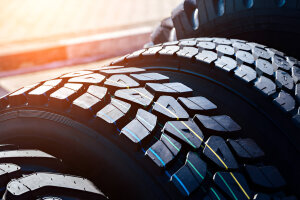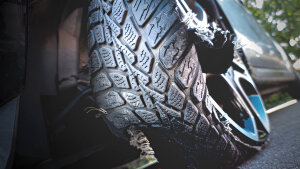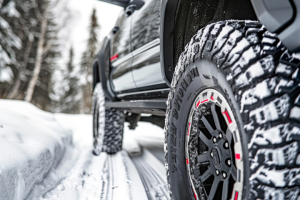Last Updated on September 19, 2025
Introduction to Run-Flat Tires for Trucks
Run-flat tires represent a significant advancement in automotive technology, offering enhanced safety and convenience compared to traditional tires. In this article, we will delve into the workings of run-flat tires, their unique structure, and the various types available for trucks.
Overview of Run-Flat Tire Technology
Run-flat tire technology is a significant development in automotive safety and efficiency, especially relevant in trucking. These tires are designed to remain functional and safe even after sustaining a puncture or severe damage, enabling vehicles to continue driving for a limited distance at a reduced speed.
Key Features of Run-Flat Tire Technology:
Explore the innovative features of run-flat tire technology. This technology enables drivers to continue their journey even after a puncture or loss of tire pressure, enhancing safety, convenience, and peace of mind on the road.
- Reinforced Sidewalls: Run-flat tires are designed with reinforced sidewall construction. This specific reinforcement is critical in enabling the tire to maintain its structural integrity and support the vehicle’s weight even after experiencing a loss of air pressure. This crucial element ensures the tire retains its shape and functionality during a puncture, allowing for continued safe operation within the manufacturer’s specified limitations.
- Self-Supporting Design: Unlike conventional tires, which lose their shape and functionality upon experiencing a puncture, run-flat tires can maintain their structural integrity even after encountering a puncture. This unique characteristic allows the vehicle to remain mobile for a limited distance and at a reduced speed, enabling drivers to reach a safe location for tire repair or replacement.
- Pressure Monitoring Systems: Often paired with tire pressure monitoring systems (TPMS), run-flat tires enable drivers to immediately alert to pressure loss, ensuring timely and safe responses to tire damage.
How They Work:
Following a puncture, the reinforced sidewalls of a run-flat tire effectively mitigate complete flattening, allowing for continued vehicle operation. This functionality, however, is subject to specific limitations. Typically, a punctured run-flat tire permits travel for a predefined distance, ranging from 50 to 100 miles, at a reduced speed, generally around 50 mph. The tire manufacturer establishes these limitations, which are contingent upon the specific design and condition of the tire.
Benefits of Run-Flat Tires for Trucks
Run-flat tires offer several distinct advantages for trucks, often transporting heavy loads over long distances and through various terrains.
Enhanced Safety:
- Preventing Roadside Breakdowns: The continued mobility afforded by run-flat tires in the event of a puncture offers significant safety benefits by mitigating the risk of accidents and roadside breakdowns. This advantage is particularly relevant for trucks that frequently travel on highways or remote areas, where immediate access to assistance might be limited. By enabling drivers to reach a safe location for repair or replacement, run-flat technology enhances operational safety and efficiency in these crucial transportation environments.
- Stability in Case of a Blowout: The reinforced structure of run-flat tires offers enhanced vehicle handling and control during a sudden tire failure. This critical safety feature is particularly beneficial for heavy trucks, where maintaining control is paramount due to their size and weight. By mitigating the complete loss of tire shape and pressure, run-flat technology helps maintain vehicle stability and maneuverability, potentially preventing accidents and improving overall safety on the road.
Operational Efficiency:
- Reduced Downtime: By allowing trucks to continue to a safe location or repair facility after tire damage, run-flat tires minimize downtime, which is critical for logistics and delivery schedules.
- Eliminating the Need for Spare Tires: The autonomous nature of these tires can negate the need to carry a spare tire, thus reducing the vehicle’s weight and increasing cargo capacity.
Cost-Effectiveness:
- Longer Lifespan: Run-flat tires are often more durable than standard tires, leading to longer service life and reduced replacement costs.
- Fuel Efficiency: By eliminating the need for a spare tire, run-flat tires can contribute to a lighter vehicle, potentially improving fuel efficiency.
Integrating run-flat tire technology into trucks is a considerable leap forward in vehicular safety and efficiency. These tires not only enhance the safety profile of trucks by mitigating the risks associated with tire blowouts but also contribute to operational efficiency, cost-effectiveness, and, potentially, better fuel economy. As such, they represent an invaluable investment for truck operators who prioritize safety, reliability, and performance in their fleet operations.
How Do Run-Flat Tires Work?
Run-flat tires are specially designed to remain operational even after being punctured. The key to their functionality is their reinforced structure, which supports the vehicle even when the tire deflates. These tires have thicker and stiffer sidewalls with multiple layers of rubber and heat-resistant cord, enabling them to maintain their shape and prevent the rim from contacting the road, even after air pressure loss. Bridgestone, for instance, specifies that their run-flat tires can continue to function for up to 50 miles at a maximum speed of 50 mph following a loss of some or all inflation pressure.
The Anatomy of a Run-Flat Tire
The defining characteristic of run-flat tires lies in their reinforced sidewall construction. These sidewalls are meticulously engineered using robust and resilient materials. This specific design feature is critical in preventing the tire from collapsing under the vehicle’s weight during a loss of air pressure. This reinforcement is essential for preserving the tire’s structural integrity and facilitating continued vehicle operation in the event of a puncture or other forms of air loss.
Different Types of Run-Flat Tires for Trucks
There are several types of run-flat tires available for trucks, each with its unique construction and advantages:
- Self-Supporting Run-Flat Tires (SSR): Run-flat tires are frequently the first thought upon encountering the term, and their robust construction distinguishes them. Compared to standard tires, they boast significantly reinforced sidewalls. This specific design element allows the tire to maintain its structural integrity and support the vehicle’s weight even after experiencing a complete loss of air pressure.
- Auxiliary-Supported Run-Flat Tires: This type of run-flat tire utilizes a unique design approach. It incorporates an internal support ring crafted from sturdy materials such as hard rubber. This ring is strategically attached to the wheel rim and resides within the tire’s inner cavity. Consequently, in the event of a complete loss of air pressure, the vehicle’s weight is transferred to this internal support structure, enabling continued mobility within specific limitations.
- Self-Sealing Run-Flat Tires: Representing a recent advancement in the run-flat tire category, this innovative type boasts self-sealing capabilities. This unique feature allows the tire to automatically seal punctures, effectively maintaining air pressure and facilitating continued vehicle operation without requiring immediate repair. This technology offers enhanced convenience and safety benefits for drivers.
Each type of run-flat tire offers different benefits and is suited for various truck applications, ranging from heavy-duty hauling to daily commuting. Additionally, many brands offer these tires in different styles, such as winter, performance, and all-season, catering to various driving conditions and preferences.
Run-flat tires for trucks enhance safety by reducing the risks associated with sudden tire deflations and provide convenience by allowing drivers to continue their journey without immediate tire replacement. With advancements in tire technology, the variety and effectiveness of run-flat tires are expected to increase, offering truck drivers more options to suit their specific needs.
Driving on Run Flat Tires
While run-flat tires provide undeniable safety and convenience benefits for truck drivers, it is crucial to acknowledge their inherent limitations and associated considerations for optimal performance. A thorough understanding of these aspects is essential for truck drivers who utilize or contemplate transitioning to run-flat tires. By carefully evaluating these factors, drivers can make informed decisions aligning with their needs and driving conditions.
Safety Features of Run-Flat Tires
Run-flat tires provide several safety advantages:
- Safety in the Event of a Puncture: The primary advantage is their ability to maintain control after a puncture, allowing drivers to reach a safe location or service center.
- Elimination of Spare Tire Need: Run-flat tires negate the need to carry a spare tire, jack, and tools, freeing up space and reducing vehicle weight.
- Improved Road Handling in Emergencies: These tires offer maintained control and enhanced road handling, reducing the risk of tire blowouts and dangerous tire changes.
- Reinforced Sidewalls: They feature reinforced sidewalls made from robust materials, allowing the tire to support the vehicle’s weight even when losing air pressure.
- Drive After Deflation: Run-flat tires can be driven for a limited distance, usually between 50 and 100 miles, at reduced speeds after losing air pressure.
Limitations of Run-Flat Tires in Trucks
However, run-flat tires also have some limitations, especially in trucks:
- Availability and Cost: Unlike standard tires, run-flat options may be less readily available, especially in specific sizes and regions. Additionally, their specialized construction often translates to a higher initial cost than conventional tires.
- Ride Quality: The reinforced sidewalls that enable run-flat functionality can contribute to a firmer and less compliant ride. This is particularly noticeable when replacing standard tires on a vehicle not designed initially for run-flats. Truck drivers prioritizing ride quality should consider this trade-off between safety and comfort.
Factors Affecting Driving Distance on Run-Flat Tires
Several factors influence how far you can drive on a flat run-flat tire:
- Tire Type and Condition: Well-maintained and newer run-flat tires will likely provide a longer driving distance than older or damaged ones.
- Speed and Driving Style: Moderate and smooth driving speeds are essential to avoid excessive stress on the tire, which could lead to further damage.
- Vehicle Weight: Heavier vehicles, like trucks carrying significant loads, exert more pressure on the tire, potentially reducing the driving distance.
- Temperature and Road Conditions: Extreme temperatures and rough road conditions can affect the tire’s performance and durability, impacting the driving distance.
- Run-Flat Tire Technology: The durability and design of the tire’s reinforced sidewalls and supportive inserts vary among run-flat tires, affecting driving distance.
- Monitoring Systems and Warning Signs: Modern vehicles equipped with tire pressure monitoring systems can detect and provide early warning signs of a flat tire, which is crucial for avoiding further damage.
- Manufacturer Recommendations: It is essential to follow the manufacturer’s guidelines on the recommended driving distance, which generally suggests no more than 50 to 70 miles at a maximum speed of 50 mph on a flat, run-flat tire.
Run-flat tires in Emergency Situations
While run-flat tires offer numerous benefits, their actual value shines during unforeseen circumstances, particularly when encountering a flat tire. Here is a comprehensive guide for truck drivers on effectively handling such scenarios:
Handling a Flat Tire Situation
Encountering a flat tire can be an unsettling experience for any driver. However, by following essential safety precautions and adopting a structured approach, you can effectively manage the situation and resume your journey with minimal disruption. This guide outlines the crucial steps involved in addressing a flat tire:
- Assess the Situation: Slow down, activate hazard lights, and find a safe spot to park away from traffic. This prevents further damage to the tire and rim.
- Change the Tire: If equipped with a spare tire and tools, change the tire, ensuring the load limit and recommended tire pressure are met. If you need more confidence, seek roadside assistance or professional help.
- Tire Maintenance: Check tire pressure regularly, especially for slow leaks. Inspect tires for wear and tear, such as sidewall bulges or cracks, and rotate tires every 5,000 to 8,000 miles.
- Prevention: Maintain proper tire pressure, avoid overloading, and drive cautiously over potholes to minimize puncture risk.
Emergency Protocols for Run-Flat Tires
Emergency protocols for run-flat tires primarily revolve around understanding their limitations and capabilities. These tires are designed to be driven on even after a puncture, allowing you to reach a safe location or service center. However, adhering to the manufacturer’s guidelines regarding the maximum distance and speed you can drive on a punctured run-flat tire is crucial. Typically, you can move between 50 to 100 miles at reduced speeds. Monitoring systems in vehicles equipped with run-flat tires can also provide alerts essential in the event of a puncture.
Run-flat tires offer a layer of safety in emergencies, allowing for continued mobility even with a flat tire. Understanding their capabilities and limitations is crucial in handling these scenarios effectively.
Maintenance and Care for Run-Flat Tires
Run-flat tires significantly advance automotive safety, offering drivers continued mobility during a puncture. However, like all tires, they require proactive maintenance and care to ensure optimal performance and longevity. This article provides essential insights into maintaining run-flat tires, identifying signs of wear, and implementing best practices to maximize their lifespan.
Regular Maintenance Tips
Regular maintenance is crucial for maximizing the performance and safety of run-flat tires. Here are essential maintenance tips:
- Regular Inspection: Inspect the tires for any signs of damage, punctures, or embedded objects.
- Tire Pressure Monitoring: Keep a close eye on tire pressure. Run-flat tires often don’t visibly sag when low on pressure, making it essential to regularly check and maintain the correct pressure.
- Balancing and Alignment: Regular tire balancing and wheel alignment checks are essential. Misalignment or imbalance can cause uneven wear and reduce tire life.
- Rotation Schedule: Follow a regular tire rotation schedule. Due to their unique construction, this helps distribute wear evenly, especially for run-flat tires.
- Professional Checks: Have your tires checked by an experienced professional, especially after encountering severe road conditions or if you suspect any issues.
Signs of Wear and When to Replace
Recognizing when run-flat tires need to be replaced is critical for safety. Look out for these signs:
- Tread Wear: Check the tread depth. If it is below 2/32 inches, it is time to replace the tire.
- Visible Damage: Look for visible signs like cuts, bulges, or blisters on the sidewalls.
- Vibration or Noise: Unusual vibrations or noise while driving can indicate internal damage, requiring tire replacement.
- Age of the Tires: Even if the tread is not worn out, tires should be replaced every six years as a general rule, as the rubber compounds deteriorate over time.
Best Practices for Extending Tire Life
To maximize the life of your run-flat tires, consider these best practices:
- Avoid Overloading: Excess weight can strain the tires, leading to premature wear.
- Smooth Driving: Avoid sudden accelerations and stops. Smooth, consistent driving reduces stress on the tires.
- Avoid Harsh Conditions: Whenever possible, avoid driving in extreme conditions like rough roads or severe weather, which can accelerate tire wear.
- Use the Right Tires for the Season: Using season-appropriate tires (like winter tires for snowy conditions) can extend the life of your regular run-flat tires.
- Regular Cleaning: Clean your tires to remove debris and inspect for damage.
Proper maintenance and care of run-flat tires are essential for ensuring safety, optimal performance, and longevity. Regular inspections, maintenance routines, and driving habits play a significant role in extending the life of these tires. By adhering to these guidelines, drivers can ensure their run-flat tires provide the best possible service throughout their lifespan.
Performance and Efficiency
Run-flat tires have gained popularity, especially for their safety benefits. However, their impact on performance and efficiency, especially for trucks, is a topic of interest for many drivers and fleet operators.
Run-Flat Tires and Fuel Efficiency
Run-flat tires offer undeniable safety benefits by enabling continued mobility after a puncture. However, a trade-off exists: their reinforced construction often increases weight compared to standard tires. This additional weight can hurt a vehicle’s fuel economy. The fundamental principle at play is inertia. A heavier vehicle requires more energy (fuel) to overcome its inertia and maintain its desired speed. Consequently, run-flat tires may potentially reduce fuel efficiency compared to conventional tires.
Impact on Truck Performance and Handling
Several factors influence the performance and handling of trucks using run-flat tires:
- Reduced Grip: Run-flat tires may provide less grip than regular tires, particularly in wet or slippery conditions. This is due to their stiffer construction and smaller footprint on the road, which results in decreased traction. This reduced grip can affect the overall handling and control of the vehicle.
- Ride Quality: While beneficial for puncture scenarios, the reinforced sidewalls of run-flat tires result in less cushioning. This can lead to a stiffer, less comfortable ride with increased vibration.
- Steering Response: Run-flat tires can alter a vehicle’s steering response. Their different construction can make steering feel less predictable and require increased steering effort, affecting the vehicle’s handling and maneuverability.
- Handling During Tire Failure: While run-flat tires can be driven on after a puncture, sudden tire failures like blowouts can significantly impact vehicle handling. The altered balance and sudden loss of air pressure can make controlling the vehicle more challenging.
- Increased Weight: The added weight of run-flat tires affects the vehicle’s suspension system and overall handling. This increased unsprung mass can reduce the suspension’s responsiveness, leading to compromised handling and potentially decreased fuel efficiency.
- Limited Distance and Speed: Run-flat tires offer continued mobility after a puncture but within certain limits. The restricted driving range and lower maximum speed compared to regular tires can be a safety concern and an inconvenience.
- Risk of Rim Damage: The stiffer sidewalls of run-flat tires can transfer more impact to wheel rims in events like hitting a pothole, increasing the risk of rim damage. This not only affects the vehicle’s aesthetics but also its handling.
- Braking Performance: Run-flat tires can lead to longer stopping distances and a change in brake feel, potentially affecting the overall control during braking and compromising emergency stops.
- Difficulty Detecting Tire Pressure Loss: Run-flat tires may not show immediate warning signs of tire pressure loss, which can delay detection and increase the risk of blowouts and accidents.
To mitigate these issues, manufacturers have developed specialized run-flat tire designs with features like unique rubber compounds and advanced cooling systems to minimize negative impacts on vehicle handling while still providing the benefits of mobility after a puncture.
While run-flat tires offer significant safety advantages, their impact on fuel efficiency and vehicle handling, particularly for trucks, is a complex interplay of various factors. Understanding these impacts is crucial for drivers and fleet operators to make informed decisions about tire choices and vehicle maintenance.
Choosing the Right Run-Flat Tires for Your Truck
Selecting the right run-flat tires for your truck is essential for ensuring safety, performance, and longevity. This guide outlines the factors to consider, top brands and models, and installation and balancing tips.
Factors to Consider When Selecting Run-Flat Tires
When choosing run-flat tires for your truck, several key factors need to be considered:
- Vehicle Compatibility: Ensure the tires are compatible with your truck’s make and model. Some vehicles are specifically designed to use run-flat tires, while others may require modifications.
- Size and Load Rating: The tire size and load rating should match your truck’s requirements. It’s crucial for maintaining vehicle handling and safety.
- Driving Conditions: Consider the typical driving conditions. If you frequently drive in areas with poor road conditions or extreme weather, look for run-flat tires designed for these environments.
- Tread Pattern: The tread pattern affects traction and performance. Choose a pattern that suits your usual driving surfaces, whether it’s highways, city roads, or off-road terrains.
- Fuel Efficiency: Some run-flat tires can decrease fuel efficiency due to added weight. Consider tires that offer a good balance between safety features and fuel economy.
- Brand Reputation and Reviews: Research brands and read customer reviews. Popular brands often have a proven track record of quality and reliability.
- Cost vs. Benefits: Run-flat tires can be more expensive than standard tires. Assess whether the added expense is justified by the benefits they offer for your needs.
Installation and Balancing
Proper installation and balancing are crucial for the performance and longevity of run-flat tires:
- Professional Installation: It is recommended that professionals install run-flat tires. They have the necessary equipment and expertise to ensure correct fitting.
- Balancing: After installation, tires should be properly balanced. This is crucial for smooth driving and even tire wear.
- Alignment Check: Have your truck’s wheel alignment checked and adjusted if necessary. Proper alignment ensures optimal handling and minimizes uneven tire wear.
- Regular Inspections: After installation, check the tires for wear and tear and ensure they are always correctly inflated according to the manufacturer’s specifications.
Choosing the right run-flat tires for your truck involves carefully considering various factors, including vehicle compatibility, tire specifications, driving conditions, and brand reputation. Proper installation and regular maintenance are crucial to maximizing the benefits of your run-flat tires. By following these guidelines, you can ensure enhanced safety, performance, and value from your investment in run-flat tires.
Real-World Experiences and Case Studies
Understanding the real-world experiences and practical implications of using run-flat tires can provide valuable insights into their effectiveness and usability. This article delves into user testimonials and comparative analyses with traditional tires, offering a comprehensive view of run-flat tires in everyday use.
User Testimonials and Stories
User testimonials provide firsthand accounts of experiences with run-flat tires. Many users have shared stories of how run-flat tires have provided peace of mind and safety, especially in emergencies. For instance, drivers have recounted cases in which run-flat tires allowed them to safely continue to their destination or a service center after experiencing a puncture, which would have otherwise left them stranded.
However, there are also accounts of the downsides. Some users have noted the higher cost of run-flat tires, both in initial purchase and replacement, as a significant drawback. Others have mentioned the firmer ride quality due to the stiffer sidewalls of these tires, which can lead to a less comfortable driving experience than traditional tires.
Comparative Analysis with Traditional Tires
A comparative analysis of run-flat tires with traditional tires involves several key factors:
- Safety in Emergency Situations: Run-flat tires protect against a puncture, allowing drivers to maintain control and drive for a certain distance without an immediate tire change. Traditional tires, in contrast, require close attention and change upon puncturing, which can be problematic in remote or unsafe locations.
- Durability and Wear: The common perception is that run-flat tires may wear out faster than traditional tires. This is often attributed to their stiffer construction and the additional weight they carry.
- Cost Considerations: Run-flat tires are generally more expensive to purchase and replace than traditional tires. This increased cost can be a significant factor for many users, especially those who do not frequently encounter situations where run-flat capabilities would be necessary.
- Ride Comfort: Traditional tires are often favored for their ride comfort. The flexible sidewalls of standard tires absorb road imperfections more effectively, providing a smoother ride compared to the stiffer run-flat tires.
- Fuel Efficiency: The added weight of run-flat tires can negatively impact fuel efficiency. Traditional tires, being lighter, offer better fuel economy.
- Convenience and Space Saving: Run-flat tires eliminate the need to carry a spare tire, freeing Space and reducing vehicle weight. This is a convenience factor that traditional tires cannot offer.
The choice between run-flat and traditional tires depends on individual preferences and priorities. While run-flat tires offer undeniable safety and convenience in specific scenarios, they also come with cost, comfort, and potentially faster wear trade-offs. Real-world experiences and comparative analyses highlight the importance of evaluating personal driving habits, routes, and budget considerations when making this choice.
Conclusion & Recommendations
Run-flat tires have revolutionized tire technology, especially in trucking, by offering enhanced safety and convenience. The primary benefit of run-flat tires is their ability to maintain functionality even after a puncture, allowing drivers to reach their destination or a service center safely. This feature significantly reduces the risk of being stranded due to a flat tire, which is crucial for trucks that often travel long distances or through remote areas.
However, these advantages come with certain limitations. Run-flat tires are generally more expensive than traditional tires in terms of initial cost and replacement. Their stiffer sidewalls can also affect ride quality, leading to a less comfortable driving experience. Additionally, the added weight of run-flat tires can impact fuel efficiency.
Despite these drawbacks, run-flat tires’ safety benefits and convenience, especially in emergencies, make them a valuable choice for many in the trucking industry.
The Future of Run-Flat Tire Technology in Trucking
Looking ahead, the future of run-flat tire technology in trucking appears promising. With ongoing research and development, we will likely see advancements that address current limitations. Future iterations of run-flat tires may become lighter, improving fuel efficiency and ride comfort. Additionally, costs may decrease as the technology becomes more widespread and production methods improve.
One potential area of growth is the integration of intelligent tire technologies with run-flat capabilities. Sensors could provide real-time data on tire condition and performance, enhancing safety and operational efficiency. This integration could be particularly beneficial in the trucking industry, where tire performance is critical to safety and cost management.
Why Tires Easy Truck
As we embrace the advancements in run-flat tire technology and anticipate its evolving role in trucking, choosing the right tires for your needs is essential. At Tires Easy Truck, we understand the importance of quality, reliability, and performance in truck tires. Our selection of run-flat tires caters to various trucking needs, ensuring you have the best safety, durability, and efficiency options.
Whether you’re looking to upgrade your truck’s tires for enhanced safety or seeking the latest in tire technology, Tires Easy Truck has you covered. We offer a wide range of top-brand run-flat tires tailored to meet the diverse demands of the trucking industry. Our expert team is always ready to assist you in selecting the perfect tires for your truck.
Explore our collection and experience the perfect blend of technology and performance.
Ensure your truck is equipped for the road ahead.
FAQs
What is the purpose of run-flat tires?
Run-flat tires are designed to maintain control and remain drivable for a limited distance, even after a puncture or complete air loss. This capability provides enhanced safety, allowing drivers to reach a safe location or a service center without needing a tire change.
Do trucks have run-flat tires?
Yes, run-flat tires are available for trucks. They offer the same safety benefits as passenger vehicles, allowing truck drivers to maintain control and drive a certain distance safely after a tire puncture, which is particularly valuable for long-haul journeys.
What is the most important thing to know about a run-flat tire?
The defining characteristic of run-flat tires is their continued functionality for a predefined period and distance, even after experiencing a complete loss of air pressure. This capability offers enhanced safety and convenience by allowing drivers to maintain vehicle control and reach a safe location for repair or replacement. However, it is crucial to emphasize that run-flat tires are not intended as a permanent solution to a flat tire. Prompt repair or replacement remains essential to ensure optimal vehicle performance and safety.
What is the science behind run-flat tires?
Run-flat tires are designed to address the safety concerns associated with traditional tires that become inoperable upon experiencing a puncture or air loss. They achieve this through reinforced sidewall construction and, in some cases, the incorporation of additional internal support structures. This specific design is crucial in mitigating complete tire collapse, even without air pressure. Consequently, run-flat tires maintain structural integrity, enabling continued vehicle operation for a limited distance and at a reduced speed.
What is the disadvantage of run-flat tires?
The main disadvantages of run-flat tires include a generally stiffer ride due to their reinforced sidewalls, higher replacement costs than standard tires, and potentially reduced fuel efficiency due to increased tire weight.
What are the three types of run-flat tires?
The three main types of run-flat tires are self-supporting, which uses reinforced sidewalls to support the vehicle’s weight; auxiliary-supported, which has an additional support ring attached to the wheel; and self-sealing, which contains a particular layer within the tire that can seal punctures as they occur.










